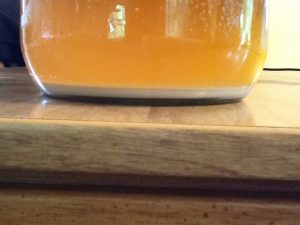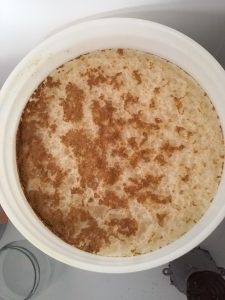Well, today I’m breaking out of my comfort zone and trying a new yeast starter method. For many years, my standard practice for a starter for an ale in the mid 60s gravity range has been to build a 2-3 qt. starter on a stir plate. I’d let the plate run 3-5 days, then put the starter in the fridge for 2-3 days to crash out the yeast. I’d decant, then pitch the slurry. It always seemed to work well, but…..
Enter Mark Van Ditta, AKA S. Cerevisiae on the AHA forum (https://www.homebrewersassociation.org/forum/). Mark’s wealth of knowledge about brewing yeast is breathtaking…he knows stuff I didn’t even know you could know! He has been advocating for making a “shaken, not stirred” starter and pitching it at high krausen rather than crashing and decanting. I have always told him that I’ve tried that and didn’t care for the results. But I decided that it was time to ditch the old fogey attitude and actually give his method a try. Which brings us to a couple days ago.
Today is Friday, 9/25/15. Last Wed. I pitched a 3 month old Wyeast smack pack of 1450 Denny’s Fav 50 (surprised?) into a 1 qt. 1.035ish OG starter at about 2 PM. By the next morning, although I didn’t see much in the way of krausen, when I shook the starter it foamed up and was obviously fermenting. Because I wasn’t ready to brew yesterday, I realized that I was gonna miss high krausen, but I figured it was close enough. I had somewhere between 3/8-1/2 inch of slurry in the bottom of my starter.

I didn’t have time to conduct this as a true “experiment” by splitting a batch of wort and pitching a different starter into each half, so I chose a recipe I know well…my Noti Brown Ale, an American style brown (http://wiki.homebrewersassociation.org/NotiBrownAle). This was the first beer I ever won an award for and I’ve brewed it many, many times.
I ended up pitching my starter at 2:30 PM into 63F wort, and placed the fermenter in my chest freezer set to 63F. 5 hours later I saw the beginning of fermentation. By the next morning, 17 hours later, the fermentation was in full swing. This time schedule was pretty much on par with what I see when I pitch a larger starter or a slurry, so there was no change in lag time. The krausen looks beautifully tan and healthy.

So far, there hasn’t been a downside to this technique. The starter was simpler to make and tool less DME, so it was less expensive than my usual starter. Of course, the proof is in the glass. I’ll report on the finished beer in a couple weeks or so.
UPDATE: Since writing this, Mark laid some new info on me….the size of the starter vessel matters! Apparently, there should be a 4:1 ratio between the size of the vessel and the amount of starter wort. More info….https://www.homebrewersassociation.org/forum/index.php?topic=24447.msg31…
